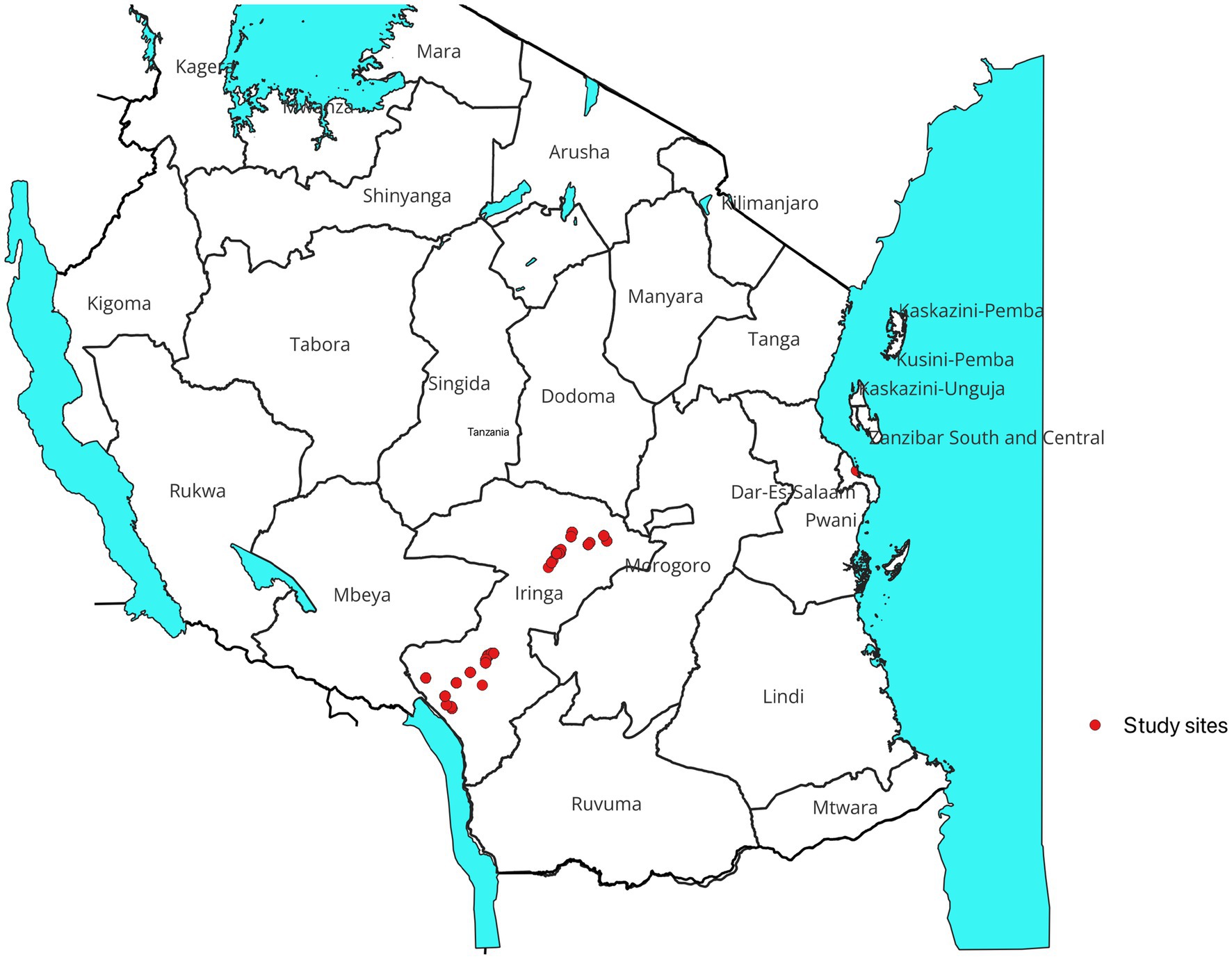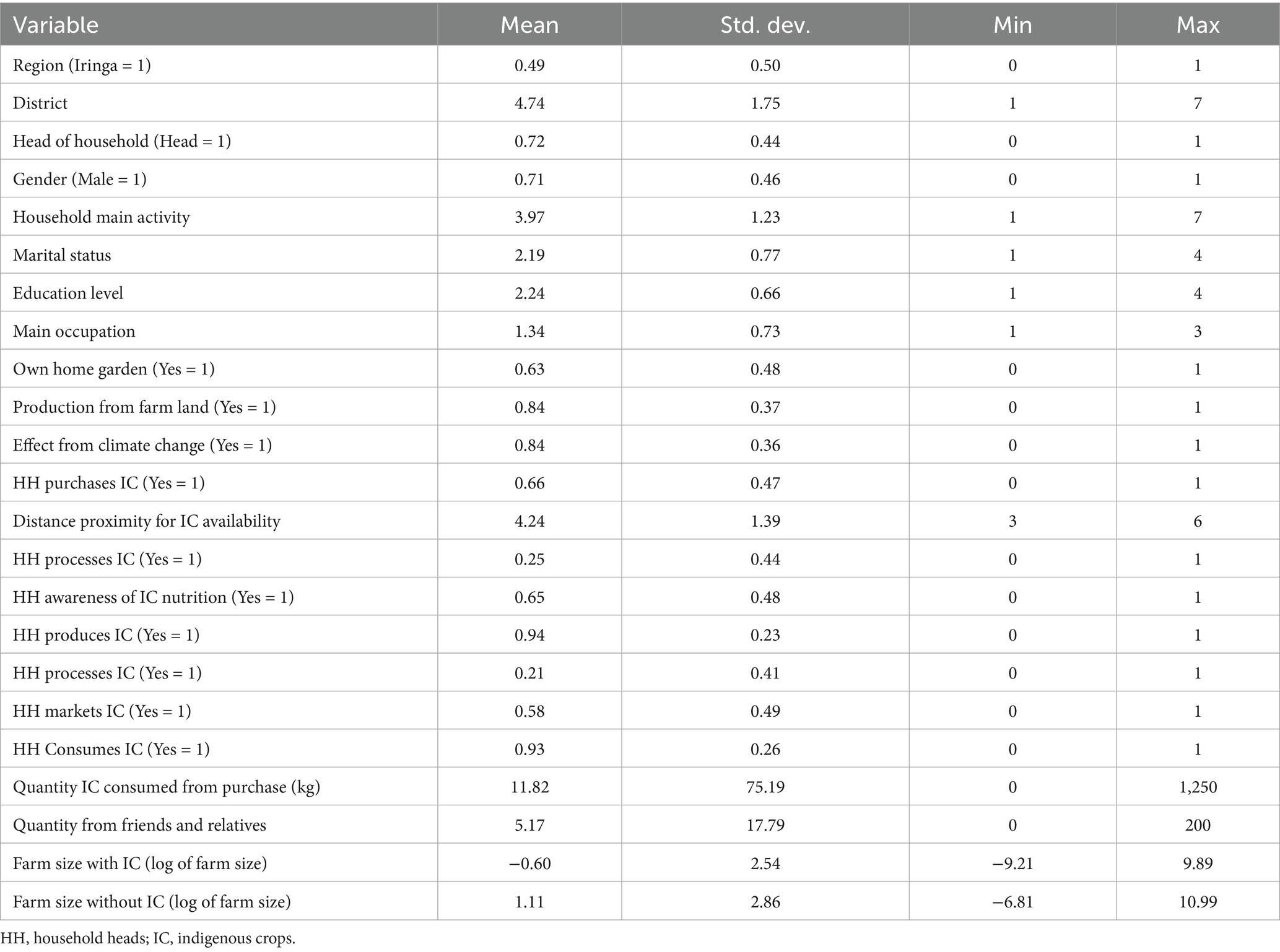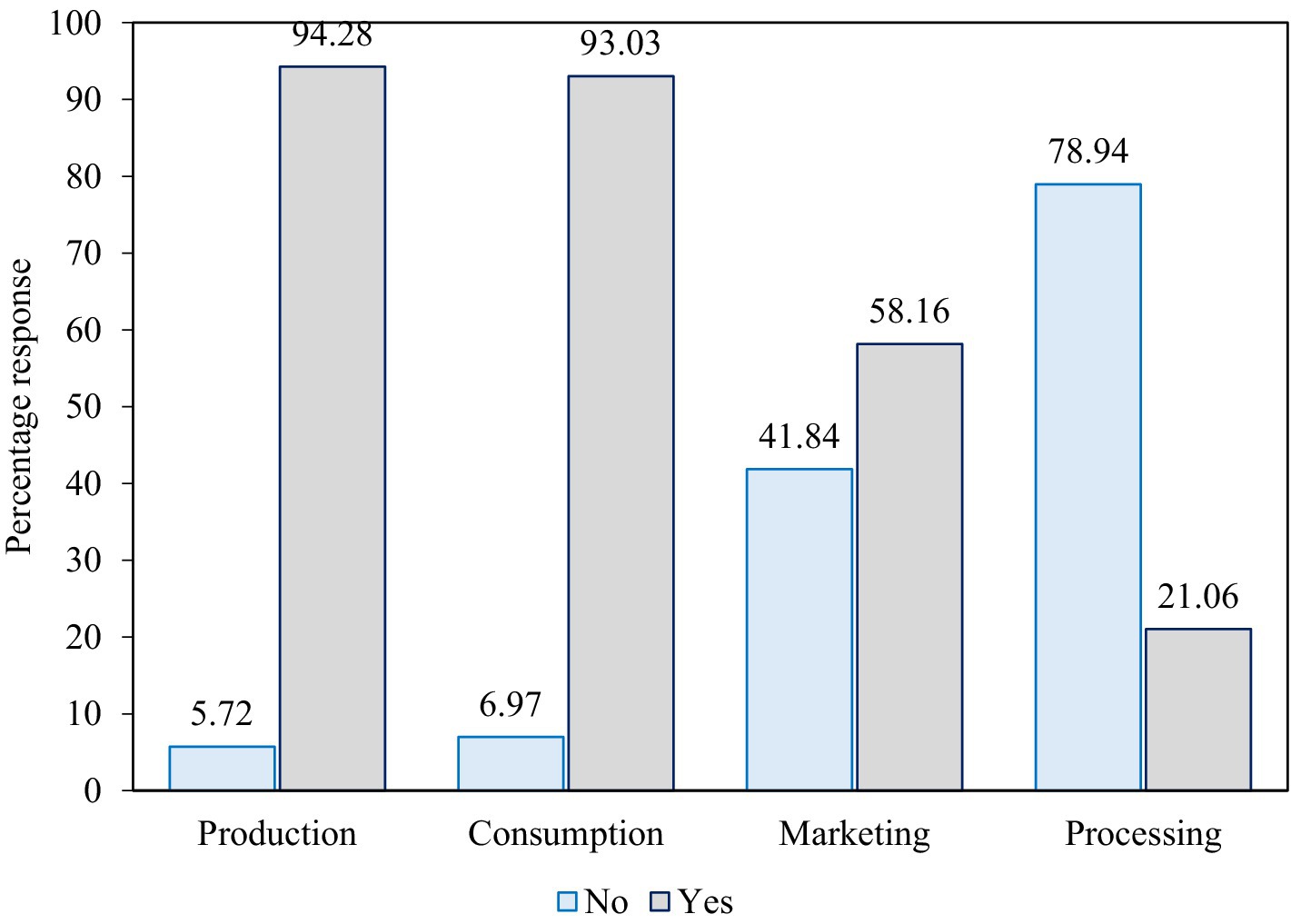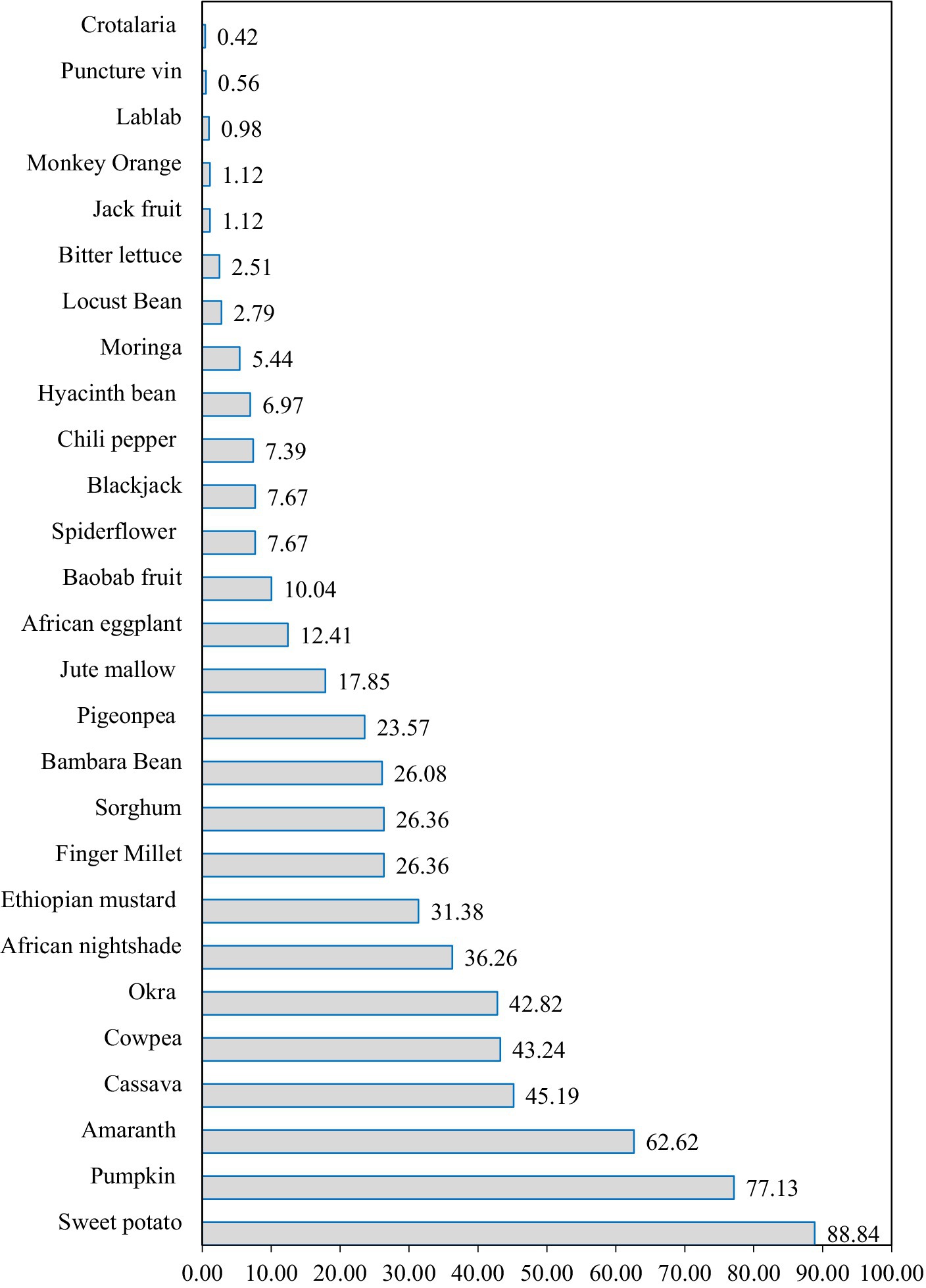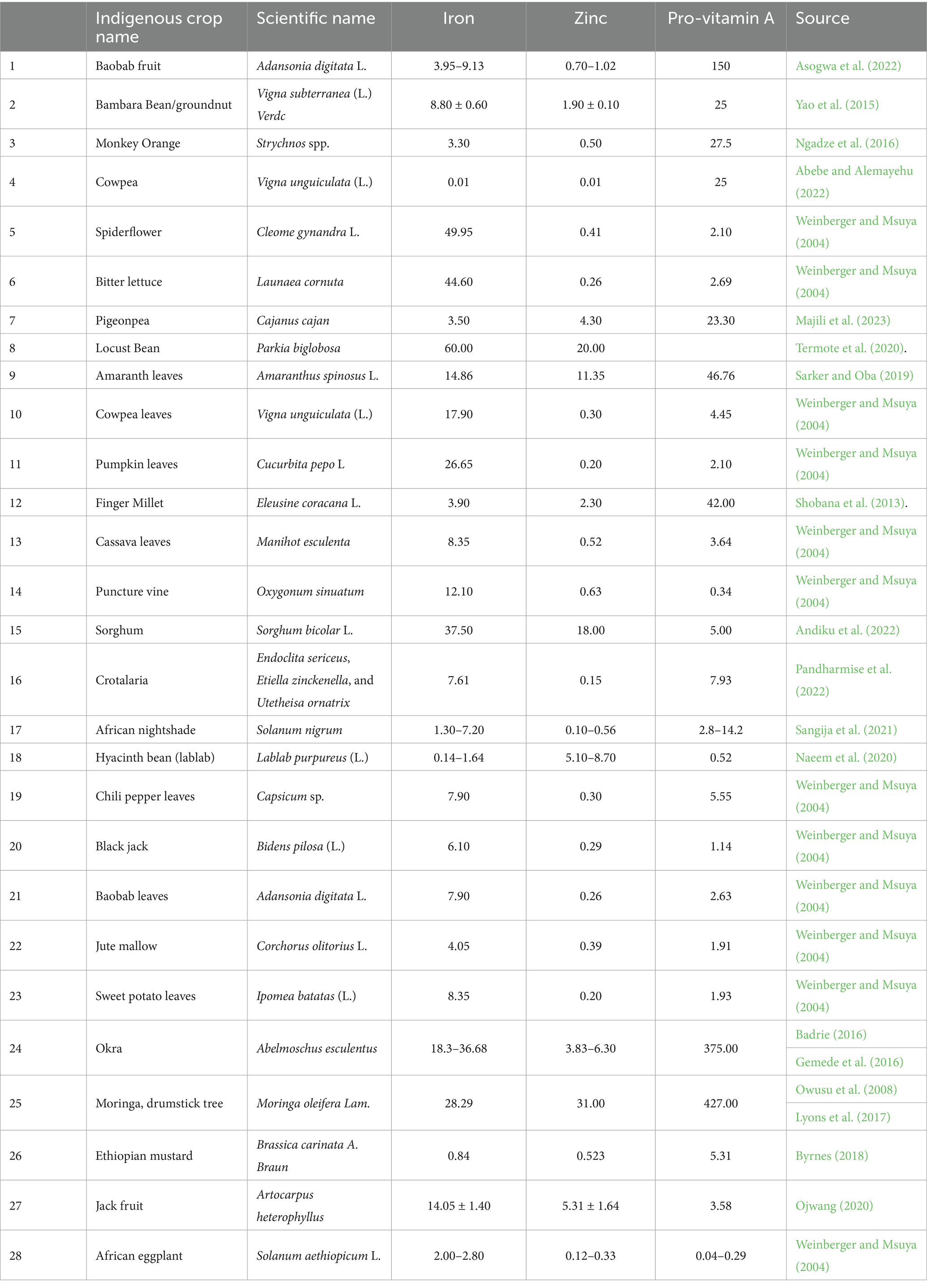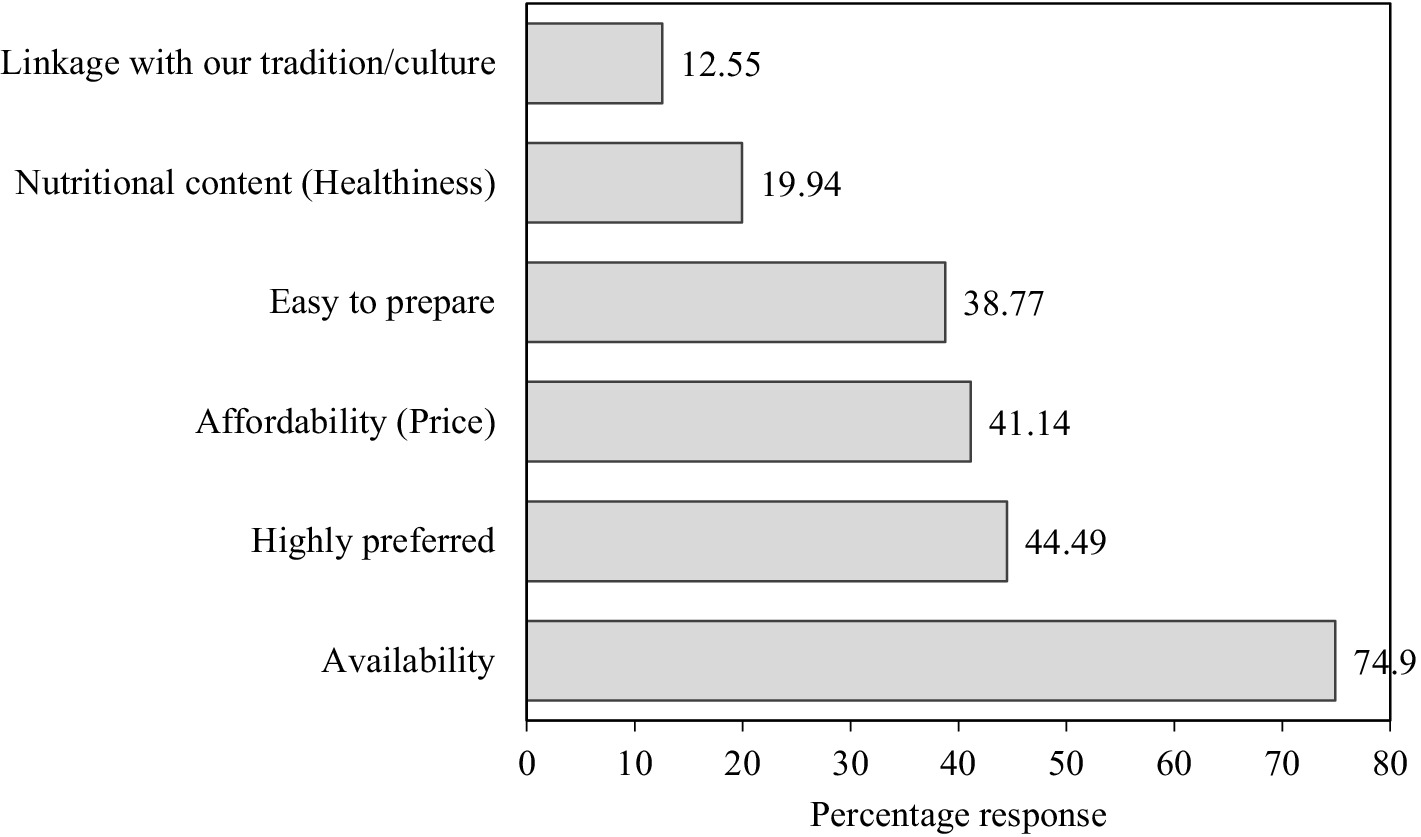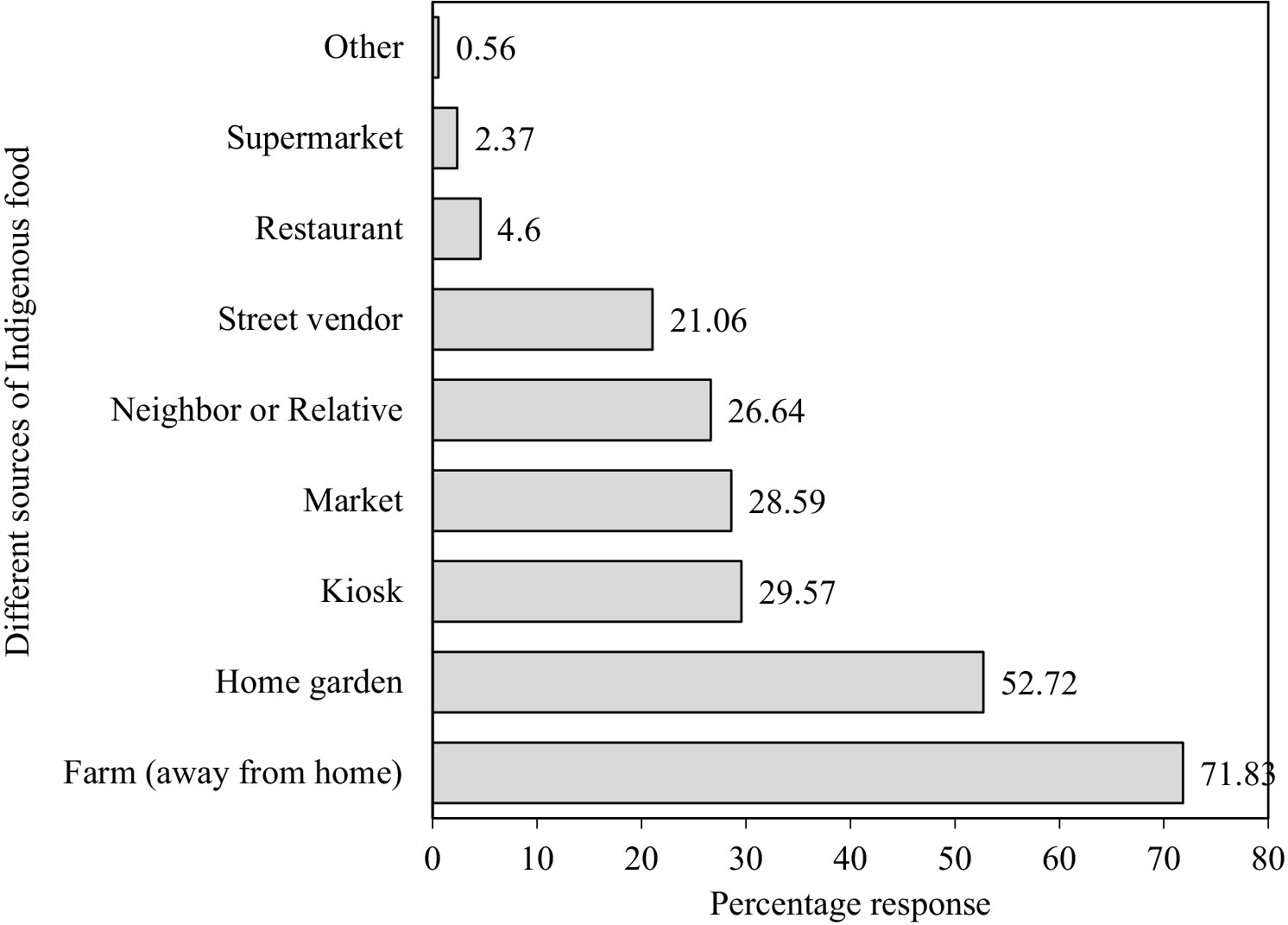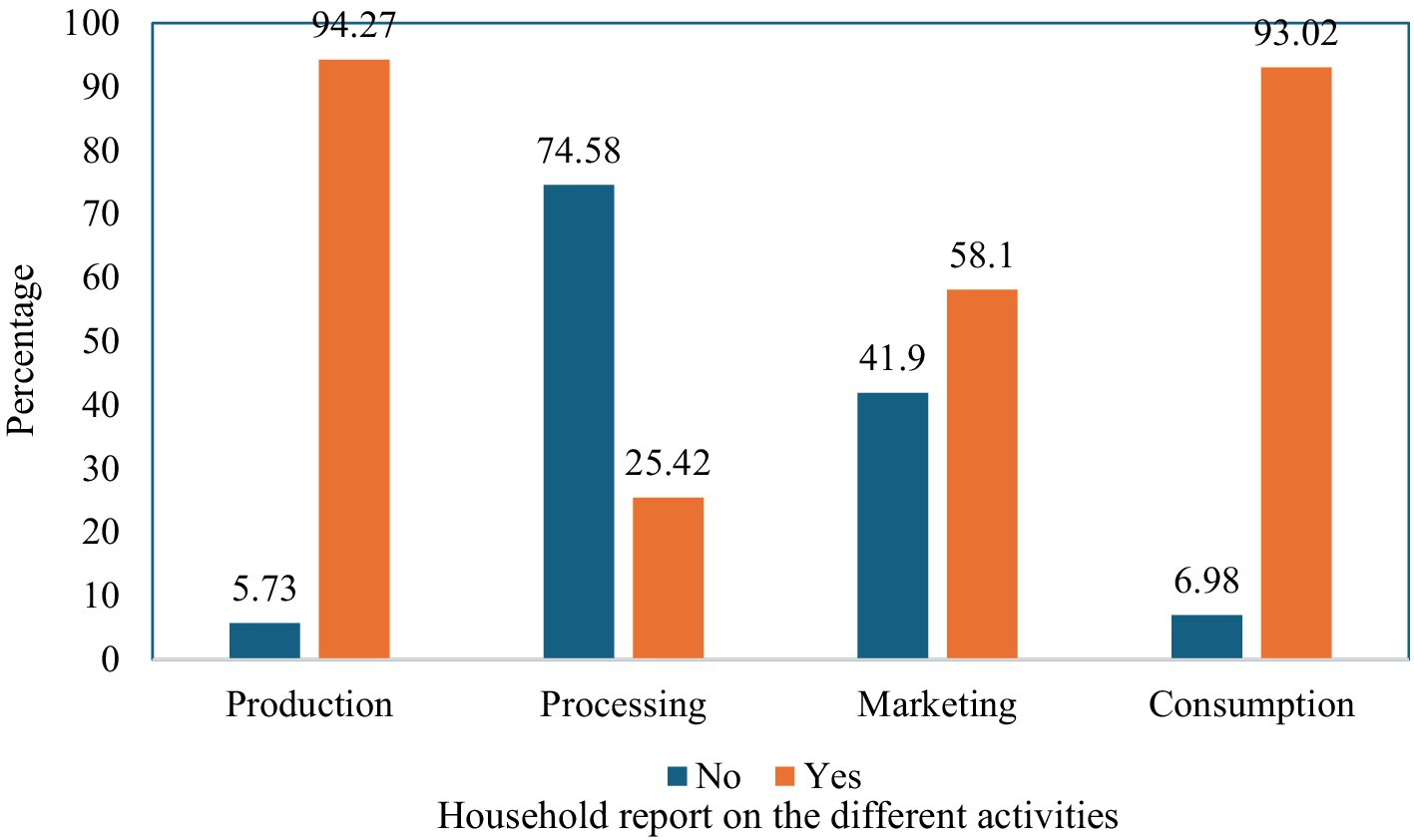- 1Department of Agricultural Economics and Business, University of Dar es Salaam, Dar es Salaam, Tanzania
- 2Department of Food Science and Technology, University of Dar es Salaam, Dar es Salaam, Tanzania
This study explores the value chain of selected indigenous crops in Tanzania, assessing their potential to address micronutrient deficiencies and contribute to food security. The research examines production patterns, processing techniques, and market dynamics, identifying key challenges and opportunities within the value chain. Crops such as amaranth, sorghum, millet, and baobab are cultivated using traditional methods, integrating local knowledge and organic inputs. The study highlights major constraints, including limited market linkages, inadequate processing infrastructure, and weak policy support, which hinder the commercialization and accessibility of these crops. Key findings reveal that while indigenous crops are widely produced and consumed, their market presence remains low due to inefficiencies in distribution channels and consumer awareness gaps. The study underscores the high nutritional value of these crops, particularly their rich content of iron, zinc, and pro-vitamin A, making them crucial in addressing malnutrition. The research further identifies opportunities for value chain improvements, such as enhanced processing methods, improved storage facilities, and policy interventions to support smallholder farmers. The study concludes that strengthening the indigenous crop value chain through targeted investments in infrastructure, policy support, and market development can transform these crops into competitive commodities. Recommendations include increasing consumer education, integrating digital marketing platforms, and fostering collaborations between stakeholders to enhance production efficiency and market access. By addressing these challenges, indigenous crops can play a pivotal role in sustainable agriculture, improving nutrition, and bolstering the livelihoods of rural farmers in Tanzania.
Highlights
• Indigenous crops are abundant in vital micronutrients, including iron, zinc, and pro-vitamin A, which play a significant role in addressing malnutrition.
• The commercialization and accessibility of these crops are impeded by weak market connections, insufficient processing facilities, and a lack of supportive policies.
• Enhancing processing methods, expanding market access via digital platforms, and raising consumer awareness can significantly improve the market position of indigenous crops.
• To effectively incorporate indigenous crops into sustainable food systems, it is crucial to implement strategic measures, including policy enhancements and investments in value chain infrastructure.
1 Introduction
Micronutrient deficiencies–often referred to as hidden hunger–continue to be a serious public health concern in Tanzania, especially in regions like Iringa, Njombe, and Rukwa (Gowele et al., 2021; TNNS, 2018). These deficiencies contribute to widespread malnutrition, impairing physical and cognitive development while increasing susceptibility to diseases (Gowele et al., 2021). Addressing micronutrient deficiencies requires innovative strategies; including the development of micronutrient-sensitive value chains. Such an approach involves integrating policy, research, and partnerships to enhance the production, accessibility, and marketing of nutrient-rich foods (Kumar et al., 2022).
Indigenous crops, native to specific regions and integral to traditional diets, hold significant potential to combat malnutrition. Often classified as orphan crops or neglected crops (Akinola et al., 2020), they are rich in essential micronutrients such as iron, zinc, and vitamin A, benefiting vulnerable populations like children and women (Aderibigbe et al., 2022; Conti et al., 2021; Gowele et al., 2021; Vincent et al., 2023). Their adaptability to local agro-ecological conditions make them a sustainable option for improving nutrition (Guodaar et al., 2021; Weinberger and Msuya, 2004). However, their underutilization stems from limited production, poor agronomic practices, inadequate market access, and low consumer awareness about their nutritional values (Schipmann and Qaim, 2011; Simon et al., 2020).
Beyond their nutritional benefits, indigenous contribute to food security, climate resilience, and biodiversity conservation. Their drought tolerance and low input requirements make them ideal for climate-smart agriculture, ensuring resilient food systems amid changing environmental conditions.
A value chain approach provides a holistic framework to analyze the production, processing, and marketing systems of indigenous crops (Donovan et al., 2015). By identifying gaps, challenges, and opportunities along the value chain, stakeholders can develop targeted interventions to enhance efficiency and sustainability (Hellin and Meijer, 2006). This approach can inform the development of targeted interventions to enhance the competitiveness, accessibility, and utilization of these crops (Kaplinsky and Morris, 2001). Strengthening the value chain for indigenous crops can bolster their role in addressing micronutrient deficiencies while also improving income generation for smallholder farmers and promoting sustainable agricultural practices (Cunningham and Saqib, 2020; Trienekens, 2011).
Moreover, value chain interventions can enhance the livelihoods of food producers while improving the availability, affordability, and quality of nutritious foods. Such intervention requires a focus on the entire chain–from production to consumption–coupled with complementary strategies like bio-fortification and modern agricultural practices to boost the micronutrient content of staple crops (Hawkes and Ruel, 2011; Jahiruddin, 2020; Sharma et al., 2024). Despite their promise, indigenous crops face significant barriers in their value chains, including inefficient agronomic practices, limited market access, and insufficient consumer awareness. Overcoming these challenges is critical to maximizing their potential in addressing micronutrient deficiencies. This research focuses on the value chain analysis of selected indigenous crops in Iringa and Njombe, two regions the Southern Highlands of Tanzania, aiming to explore factors that hinder their production, processing, and marketability.
Therefore, the study aims first to examine the dynamics of indigenous crops, with an emphasis on identifying key crop varieties in the production, processing, consumption, and nutritional values. Second to investigate the factors affecting the production, processing, and market accessibility of indigenous crops, especially those with the potential to combat micronutrient deficiencies. Third to analyze challenges, gaps, and opportunities for indigenous crops to strengthen their competitiveness in local, regional, and international markets.
2 Materials and methods
The survey was conducted in the Iringa and Njombe regions within the Southern Highlands of Tanzania (Figure 1) from mid-June to mid-July 2024, spanning approximately 4 weeks. It covered three districts in Njombe Regions—Njombe Council, Makete, Wanging’ombe—and three districts in Iringa Region—Iringa Council, Iringa Rural, and Kilolo. These regions were selected based on their high levels of malnutrition and stunting, a form of chronic malnutrition prevalent in the Southern Highlands of Tanzania.
In Tanzania, undernutrition remains a critical public health concern, particularly among schoolchildren from underprivileged communities in both urban and rural areas. The most prevalent nutritional challenges include stunting (21–79%), anemia (29–80%), iron deficiency (33%), and vitamin A deficiency (32%) (Gowele et al., 2021). The Southern Highlands, especially Iringa and Njombe, are among the most affected regions. According to the Tanzania National Nutrition Survey (TNNS, 2018), undernutrition rates are highest in Njombe (54%), followed by Iringa (51.3%), Katavi (48%), Kagera (47.9), Songwe (43%), and Kigoma (42%). Despite these challenges, Iringa and Njombe are also considered Tanzania’s agricultural basket regions due to their high crop productivity.
This study employed purposive sampling to select farmers involved in various activities along the value chain for indigenous crops. Participants were selected from 24 villages distributed across the six districts, with approximately 716 individuals voluntarily taking part in the study. Data were collected by trained enumerators through face-to-face interviews using a structured questionnaire implemented in the Kobo Toolbox.
A cross-sectional research design was used to assess the production of selected indigenous crops with the potential to alleviate micronutrient deficiencies. The study focused on evaluating household level nutritional awareness and the usage patterns of indigenous crops while identifying key stakeholders in the value chain, including producers, processors, and marketers.
Ethical clearance was obtained from the relevant institutional review board, and permission was secured from local authorities in the respective regions. All participants were informed about the purpose of the study, and informed consent was obtained before participation. Confidentiality and anonymity of respondents were strictly maintained throughout the research process.
3 Results and discussion
3.1 Descriptive statistics
Results from Table 1 show the key variables used in the analysis. The variable region shows that approximately 49.3% of households fell within the Iringa region and the other 50.7% in the Njombe region. The near-equal distribution between the two regions suggests a balanced geographic representation in the sample. The household head variable indicates that 72.91% of the households were male-headed, while the remaining 27.09% were female-headed, reflecting a predominant male-headed household structure. Similarly, the gender variable shows that 70.53% of respondents were male, with the remaining 29.47% being female, which aligns closely with the household head data. Marital status showed diversity, with values ranging from 1 to 4, capturing a broad spectrum of marital situations across the sample.
The education variable, with a mean of 2.24, provides further insight into formal education, indicating that a significant proportion of individuals had basic education (primary and secondary levels). Regarding occupation, 33.48% of households were involved in agriculture, while the remaining 66.52% engaged in a range of other occupations, likely including service, trade, and small businesses.
A key insight from the dataset is the significant role of home gardens, with 62.85% of households maintaining them for food production. This high percentage reflects the common practice of household-level food cultivation, particularly in rural and peri-urban areas where it is vital for food security.
The data also indicate that 83.52% of households relied on farming for their food supply, and 84.36% recognized climate change as a major factor affecting their agricultural activities. This suggests that most households not only depended on farming but also perceived climate variability as a critical challenge.
Additionally, the data show that 66.06% of households purchased indigenous foods, emphasizing the importance of market access and external food sources in complementing home-based food production. On average, households lived 4 to 5 kilometers from key produce areas—a moderate distance that could influence food sourcing frequency and cost.
Only 25.42% of households engaged in processing indigenous foods, suggesting that most of these foods were consumed in their raw or minimally processed forms. In this study, minimal processing refers to basic techniques that preserve the nutritional composition of indigenous foods, including steaming, boiling, drying, roasting, and pounding. While a small proportion of households processed these foods, this does not imply that the remaining 74.58% consumed them raw.
Although 64.80% of respondents were aware of indigenous foods, awareness alone does not ensure proper utilization or integration into daily diets. The ways in which these foods are prepared, processed, and consumed significantly impacts their nutritional benefits. Additionally, factors such as availability, affordability, taste preferences, and cultural perceptions may limit their potential to address malnutrition.
The relatively low number of households purchasing large quantities of indigenous crops may reflect economic constraints, seasonal availability, or a preference for homegrown sources over market purchases rather than a lack of knowledge about their benefits.
In terms of production, 94.27% of households were involved in food production, confirming a strong reliance on agriculture for household food security. However, only 20.95% of households processed their food, likely due to limited infrastructure or access to preservation technology. Market participation was moderate, with 58.10% of households engaging in market-related activities, while consumption remained high, with 93.02% regularly consuming the foods they produce. While 58.10% of households engaged in market-related activities, the scale and frequency of participation varied significantly, with some selling small quantities in informal markets and others accessing structured markets.
Limited processing (20.95%) may also influence market participation, as unprocessed indigenous foods often have a shorter shelf life, limiting their commercial viability. Households that process foods, such as through drying, roasting, or milling into flour, may have better opportunities for market integration, allowing them to reduce post-harvest losses and enhance value addition. However, challenges such as infrastructure, access to technology, and market linkages constrain both processing and commercialization.
Disparities in indigenous crop consumption and production were evident, as reflected in large standard deviations. While a small percentage of households produced and consumed substantial quantities, most engaged at much lower amounts. Although the data indicate that a majority of households consumed indigenous crops, the quantities varied significantly. The large standard deviations suggest that while some households had ample access, others consumed minimal quantities, potentially insufficient to meet their nutritional needs.
The discrepancy may stem from differences in how households obtain indigenous crops—whether through home production, market purchases from neighbors or relatives. Extreme values highlight the heterogeneous nature of agricultural production, where some households operate at a subsistence level, while others produce excess for sale or distribution.
Farm size disparities further confirms these inequalities, with a small proportion of households controlling significantly larger landholdings. This distribution impacts food production, market access, and income levels, which in turn influence food security. Additionally, the average distance from key produce areas may affect accessibility, particularly for lower-income households.
In summary, the dataset highlights the central role of agriculture in household food security, with significant reliance on home production and local markets for indigenous food sourcing. While 64.80% of households were aware of indigenous crops, this awareness does not always translate into high consumption. Factors such as affordability, cultural perceptions, taste preferences, and availability influence the extent to which these foods are integrated into daily diets. Moreover, only 20.95% of households engaged in food processing, suggesting that limited infrastructure, lack of preservation technology, and low market incentives may hinder value addition and long-term utilization of indigenous crops.
Market participation was also moderate, with 58.10% of households engaging in market-related activities, further reinforcing the idea that many households relied more on home production rather than purchasing indigenous crops. However, disparities existed in indigenous crop consumption and production, as reflected in large standard deviations—a small percentage of households produced and consumed significant quantities, while most operated at a subsistence level with much lower consumption.
Home gardens played a crucial role in indigenous food sourcing, with 62.85% of households cultivating them, particularly in rural and peri-urban areas where they serve as a key strategy for food security and dietary diversity. Despite this, constraints such as seasonal variations, climate change (recognized as a challenge by 84.36% of households), and limited access to processing and storage technologies may further impact the stability of indigenous food supply and consumption.
These findings provide a comprehensive understanding of the factors shaping indigenous food production and consumption behaviors, underscoring the need for policies that support smallholder farmers, improve market access, enhance process capacity, and foster sustainable agricultural practices (Guodaar et al., 2021). Addressing the challenges in processing, market participation, and production disparities will be crucial in maximizing the potential of indigenous crops for food security and nutrition.
3.2 Indigenous crop activities and cultivation patterns
The findings indicate a high level of engagement in various activities related to indigenous crops, with notable disparities in production, consumption, marketing, and processing. A substantial majority of respondents (94.28%) reported participating in production activities, leaving a mere 5.72% who did not participate (Figure 2). Likewise, the consumption of indigenous crops was prevalent, with 93.03% of respondents affirming their consumption, while only 6.97% abstained.
The high involvement in production (94.28%) and consumption (93.03%) of indigenous crops reflects their cultural and economic importance, but it does not necessarily indicate a direct link to knowledge of their nutritional benefits. While traditional knowledge may influence cultivation, some farmers grow these crops out of habit or economic necessity rather than nutritional awareness.
In contrast, participation in marketing was moderate. While 58.16% of respondents were involved in marketing efforts, 41.84% were not, suggesting that a significant portion remains disengaged. The moderate marketing participation (58.16%) suggests that production is more supply-driven than demand-driven. If nutritional awareness were a key factor, stronger market engagement, value-added processing, and support from agricultural extension or health education programs would be expected.
This highlights the role of marketing in shaping knowledge and consumption patterns of indigenous crops by enhancing awareness (through advertisements, community campaigns, and educational programs), influencing consumer behavior (via branding, product diversification, and value-added processing), and driving demand (by connecting producers, processors, and consumers through structured marketing systems).
Given that 41.84% of respondents were not engaged in marketing, expanding marketing initiatives presents an opportunity to boost awareness, improve accessibility, and increase consumption of indigenous crops. Strengthening marketing strategies could ultimately enhance food security, nutritional diversity, and economic benefits for local communities.
The lowest level of participation was noted in the processing of indigenous crops, with only 21.06% of respondents reporting engagement in processing activities, while a considerable majority, 78.94%, did not participate (Figure 2). This finding underscores a potential deficiency in value addition and processing opportunities within the indigenous crop value chain, highlighting an area ripe for future intervention and development (Hawkes and Ruel, 2011).
While indigenous crop production and consumption are widespread, marketing and processing remained underdeveloped, presenting opportunities for improved utilization and economic benefits. Despite high production (94.28%) and consumption (93.03%), this does not necessarily reflect nutritional awareness, as many farmers cultivate these crops out of habit or economic necessity.
Figure 3 illustrates the cultivation patterns of indigenous crops for the current season, emphasizing both the diversity and prevalence of these crops. Sweet potato emerged as the predominant crop, cultivated by 88.84% of respondents. It was closely followed by pumpkin, with a cultivation rate of 77.13%, and amaranth at 62.62%, reflecting their significance and popularity among local farmers. Other crops, including cassava (45.19%), cowpea (43.24%), and okra (42.82%), also demonstrated considerable cultivation levels, highlighting their importance within the local food system. Mid-tier crops such as African nightshade (36.26%) and Ethiopian mustard (31.38%) contributed to the diversity of diets and nutritional benefits. Additionally, grains like finger millet and sorghum were cultivated at moderate rates, each representing 26.36% of the total. Bambara bean (26.08%) and pigeon pea (23.57%) also played a vital role in agricultural production. Conversely, crops such as jute mallow (17.85%), African eggplant (12.41%), and baobab fruit (10.04%) exhibited lower cultivation rates, indicating limited yet noteworthy production. Even less common were crops like spider flower (7.67%), blackjack (7.67%), chili pepper (7.39%), and hyacinth bean (6.97%). At the lower end of the spectrum were crops with minimal cultivation, including moringa (5.44%), loose bean (2.79%), bitter lettuce (2.51%), and jackfruit (1.12%). Rarely cultivated crops consisted of monkey orange (1.12%), lablab (0.98%), puncture vine (0.56%), and crotalaria (0.42%), as shown in Figure 3.
Lastly, while certain indigenous crops such as sweet potato, pumpkin, and amaranth are prevalent this season, a variety of other crops are cultivated to varying extents, contributing to agricultural diversity. The low cultivation rates of some crops present opportunities to promote lesser-known varieties, which could enhance food security and community resilience.
The popularity of sweet potato, pumpkin, and amaranth may be influenced by multiple factors, including both traditional and scientific awareness of their nutritional benefits. These crops are widely recognized for their high vitamin and mineral content, such as vitamin A in pumpkins and sweet potatoes and iron in amaranth. Traditional knowledge, passed down through generations, highlights their dietary importance, while scientific research and nutrition programs reinforces their health benefits. Additionally, their ease of cultivation, adaptability to local climatic conditions, short growing cycles, and versatile culinary applications likely contribute to their widespread production.
However, further investigation is needed to determine whether their popularity is primarily driven by awareness or other factors such as market demand, yield stability, or seasonal availability.
3.3 Micronutrient level of indigenous crops
Among the indigenous crops, baobab fruit stands out for its exceptionally high levels of pro-vitamin A, with 150.00 μg, making it a key source of this essential nutrient (Table 2). It also provides significant amounts of iron (9.30 mg) and zinc (1.80 mg), yield a total average micronutrient score of 53.70. Bambara bean/groundnut is notable for its iron content (80.44 mg) and zinc (10.94 mg), both significantly higher than in other crops, while its pro-vitamin A content stands at 25.00 μg, resulting in an overall average micronutrient score of 38.79. Monkey orange provides a balanced mix, with zinc (28.73 mg) being its highest nutrient, followed by iron (9.77 mg) and pro-vitamin A (27.50 μg), resulting in an average micronutrient score of 22.00. Cowpea also offers a notable amount of iron (13.02 mg) and zinc (8.99 mg), along with pro-vitamin A (25.00 μg), contributing to an average micronutrient score of 15.67. Lastly, the spider flower has the highest iron content (30.30 mg) among these crops, although its zinc (0.47 mg) and pro-vitamin A (2.67 μg) are lower, yielding an average micronutrient score of 11.15. These crops are all valuable sources of essential nutrients, contributing significantly to improving nutritional intake in many regions.
While the micronutrient composition of these indigenous crops provides valuable information, the bioavailability of these nutrients can be influenced by the presence of enhancers and antinutritional factors for vitamin and mineral absorption phytates, tannins, and oxalates can reduce the bioavailability of minerals such as iron and zinc. However, the presence of vitamin C and certain amino acids can help enhance the absorption of non-heme iron, counteracting some of these inhibitory effects. For instance, baobab fruit, rich in vitamin C, may enhance iron absorption, whereas Bambara bean and cowpea contain phytates, which could inhibit mineral uptake. Several studies have reported that traditional processing methods—such as fermentation, soaking, and sprouting—can reduce inhibitors and improve nutrient absorption (Faizal et al., 2023; Rousseau et al., 2020; Samtiya et al., 2020).
Among the indigenous crops, the five with the lowest nutrient levels in various categories include African eggplant, jackfruit, Ethiopian mustard, moringa (drumstick tree), and okra. African eggplant stands out for having the lowest micronutrient levels overall, with only 0.93 in its average score, as it contains very small amounts of pro-vitamin A (0.17 μg), iron (2.40 mg), and zinc (0.23 mg). Jackfruit also has a low average micronutrient score of 1.95, with iron at 1.20 mg, zinc at 1.07 mg, and pro-vitamin A at 3.58 μg. Ethiopian mustard follows closely with an average micronutrient score of 2.17, offering 1.00 mg of iron, 0.20 mg of zinc, and 5.31 μg of pro-vitamin A. Moringa (drumstick tree) provides 2.41 in average micronutrient score, with iron at 2.43 mg, zinc at 0.38 mg, and pro-vitamin A at 4.44 μg. Okra, with the lowest pro-vitamin A at 2.50 μg, and iron at 1.70 mg, has a relatively low average micronutrient score of 2.68 (Table 2). These crops, while still containing essential nutrients, offer lower levels compared to other indigenous plants, highlighting the diversity in nutrient content across different crops. Vincent et al. (2023) demonstrated that orphan crops (indigenous or underutilized crops) can provide essential micronutrients to vulnerable populations while promoting dietary diversity.
3.4 Factors influencing indigenous food choices
The decision-making process regarding the purchase and consumption of indigenous foods is predominantly influenced by availability, as indicated by 74.9% of respondents who regard it as a crucial factor (Figure 4). This finding suggests that individuals are inclined to select foods that are easily obtainable. Additionally, personal preference significantly impacts choices, with 44.49% of participants stating that they favor foods they find enjoyable. Affordability also emerges as a vital consideration, with 41.14% acknowledging that price affects their purchasing behavior. Convenience of preparation is also an important aspect, with 38.77% of respondents valuing ease in meal preparation.
The preparation methods commonly used for indigenous foods include steaming, boiling, drying, roasting, and pounding. Steaming and boiling help retain water-soluble vitamins but may cause losses with prolonged cooking. Drying extends shelf life and concentrates nutrients but reduces heat-sensitive vitamins. Roasting enhances flavor, improves digestibility, and reduces anti-nutrients, while pounding alters texture and can impact nutrient availability by breaking down fiber structures (Rousseau et al., 2020).
Enjoyment of indigenous foods is influenced by both traditional and scientific knowledge, though the relationship is complex. Traditional knowledge shapes preferences through cultural practices and perceived health benefits, while scientific awareness can reinforce or reshape enjoyment by highlighting nutritional value. However, taste, texture, and familiarity often drive food choices more than conscious awareness of health benefits. Bridging this gap through education and promotion could increase consumption by aligning taste preferences with nutritional awareness.
Despite these influences, the nutritional value or health benefits of the foods is of moderate importance, cited by 19.94% of respondents, indicating that while health considerations are relevant, they do not dominate consumer choices (Figure 4). Lastly, the connection to tradition or culture is the least influential factor, at 12.55%, suggesting that cultural associations with indigenous foods have a limited impact on consumption decisions. Overall, these results emphasize that practical factors such as availability, personal preference, cost, and convenience are the primary drivers of indigenous food selection. This highlights the significance of accessibility and consumer preferences in shaping consumption trends.
In summary, Indigenous food choices are primarily driven by practical factors such as availability, personal preference, cost, and convenience, while tradition and cultural associations play a minor role. Food preparation methods—steaming, boiling, drying, roasting, and pounding—affect nutrient retention and sensory qualities, with some methods enhancing shelf life and nutrient digestibility while others impact vitamin content. Enjoyment of these foods is shaped by both cultural traditions and scientific knowledge, though taste, texture, and familiarity often outweigh health considerations. Bridging this gap through education and promotion could help increase the consumption of indigenous foods by aligning preferences with nutritional awareness.
3.5 Sources of indigenous foods for households
Indigenous foods and ingredients are obtained from a diverse array of sources, which reflect cultural preferences and the availability of these foods. Among the identified sources, farms located away from residential areas serve as the predominant supplier, representing 71.83% of households (Figure 5). This significant proportion underscores the reliance on traditional agricultural practices and the critical role of cultivating indigenous crops in rural or peri-urban settings. These farms typically offer fresh, naturally cultivated produce that meets the desires of households seeking authenticity and cost-effectiveness in their food options. Home gardens occupy the second position, with 52.72% of households utilizing them for indigenous food sources. This substantial amount highlights the importance of home gardening as a sustainable and accessible method for growing vital crops and herbs for personal consumption. Home gardens not only enhance food security but also aid in the conservation of indigenous plant species, granting households direct oversight over the quality of their produce. Kiosks and markets also serve as significant sources, with 29.57 and 28.59% of households sourcing their ingredients from these venues, respectively (Figure 5).
These establishments cater to urban and semi-urban populations, offering a wide variety of indigenous foods in easily accessible locations. The slightly greater reliance on kiosks suggests their convenience and potentially lower prices compared to larger market environments. The role of neighbors or relatives in the food supply is notable, accounting for 26.64% of sourcing, which illustrates the ongoing significance of communal and familial networks in food sharing and trade. This source reflects the entrenched cultural practices within many communities, where food exchange fosters social connections and encourages the distribution of indigenous foods. Although street vendors represent a smaller segment, they still supply 21.06% of households. These vendors are particularly important in urban contexts, providing ready-to-eat indigenous foods or ingredients for quick meal preparation. However, the lower percentage indicates that street vendors may serve a supplementary role rather than being a primary source of food supply.
3.6 Indigenous crops: production, processing, marketing, and their role in food security
The results indicate that indigenous crops play a significant role in household food security and livelihoods (Akinola et al., 2020: FAO, 2021). A large proportion of households (about 94%) engage in indigenous crop production, suggesting widespread cultivation and accessibility (Figure 6). However, only 25% of households participate in processing, while 75% do not, highlighting a major gap in value addition. This could be due to limited access to processing facilities, lack of knowledge, or insufficient incentives for households to invest in processing activities (Cunningham and Saqib, 2020).
While the high participation in indigenous crop production (94%) suggests widespread cultivation, it does not necessarily indicate strong awareness of their nutritional benefits. Many households grow these crops due to tradition, economic necessity, or availability, rather than a conscious understanding of their health advantages. Nutritional value is a less dominant factor in food selection, with only 19.94% of respondents prioritizing it. This suggests that the production of indigenous crops is mainly driven by practical needs and market opportunities, rather than informed nutritional choices. Addressing this gap through education, awareness campaigns, and integrating nutritional information into agricultural extension services could enhance the utilization of indigenous crops for their health benefits. Expanding processing and marketing initiatives could also help reposition these crops as valuable sources of essential nutrients.
Regarding marketing, 58% of households sell their indigenous crops, showing that more than half of producers commercialize their harvest. However, 42% do not market their crops, likely due to poor market linkages, low demand, or a focus on household consumption (Conti et al., 2021). The challenges related to poor market linkages include limited access to established market networks, inadequate transportation infrastructure, high transportation costs, and the lack of storage facilities or cold chain infrastructure, which leads to crop spoilage and limits market participation. Additionally, limited demand for indigenous crops, influenced by consumer preferences and a lack of awareness of their nutritional benefits, further contributes to low market engagement. Despite these challenges, consumption remains high, with 93% of households consuming indigenous crops, highlighting their importance in household diets, possibly due to their nutritional value and cultural significance (Jahiruddin, 2020). Overall, while indigenous crops are widely produced and consumed, the low levels of processing and moderate market participation suggest areas for improvement. Strengthening processing capacities and enhancing market access could create economic opportunities while promoting the nutritional benefits of these crops (Vincent et al., 2023).
The production, processing, and market accessibility of indigenous crops, particularly those with the potential to combat micronutrient deficiencies, are significantly influenced by awareness of their nutritional value, farmland production, and home garden production. In this study, farmland production refers to large-scale cultivation for commercial sale or meeting larger household needs, often with intensive farming practices. In contrast, home garden production is smaller-scale and often subsistence-based, typically carried out within or near households, with a focus on providing diverse, nutritious foods for household consumption. While both contribute to food security, farmland production ensures larger-scale food availability and potential market surplus, whereas home gardens directly enhance household nutrition by offering a variety of fresh foods, often improving micronutrient intake. Both forms of production are essential, with home gardens playing a more immediate and diverse role in nutrition.
Nutritional awareness plays a crucial role in shaping production and consumption patterns. With 65% of households aware of the nutritional benefits of indigenous crops, there is potential for increased demand and cultivation (Figure 7). However, the 35% who lack awareness may limit the adoption of these crops, reducing their impact on food security and nutrition (Padulosi et al., 2019). Greater awareness can stimulate both production and market demand, encouraging farmers to cultivate more and processors to invest in value addition (Kumar et al., 2022). Awareness is crucial in the adoption of indigenous crops because it directly influences perception, demand, and decision-making. When people are informed about the nutritional benefits, economic potential, and environmental advantages of these crops, they are more likely to cultivate, consume, or promote them.
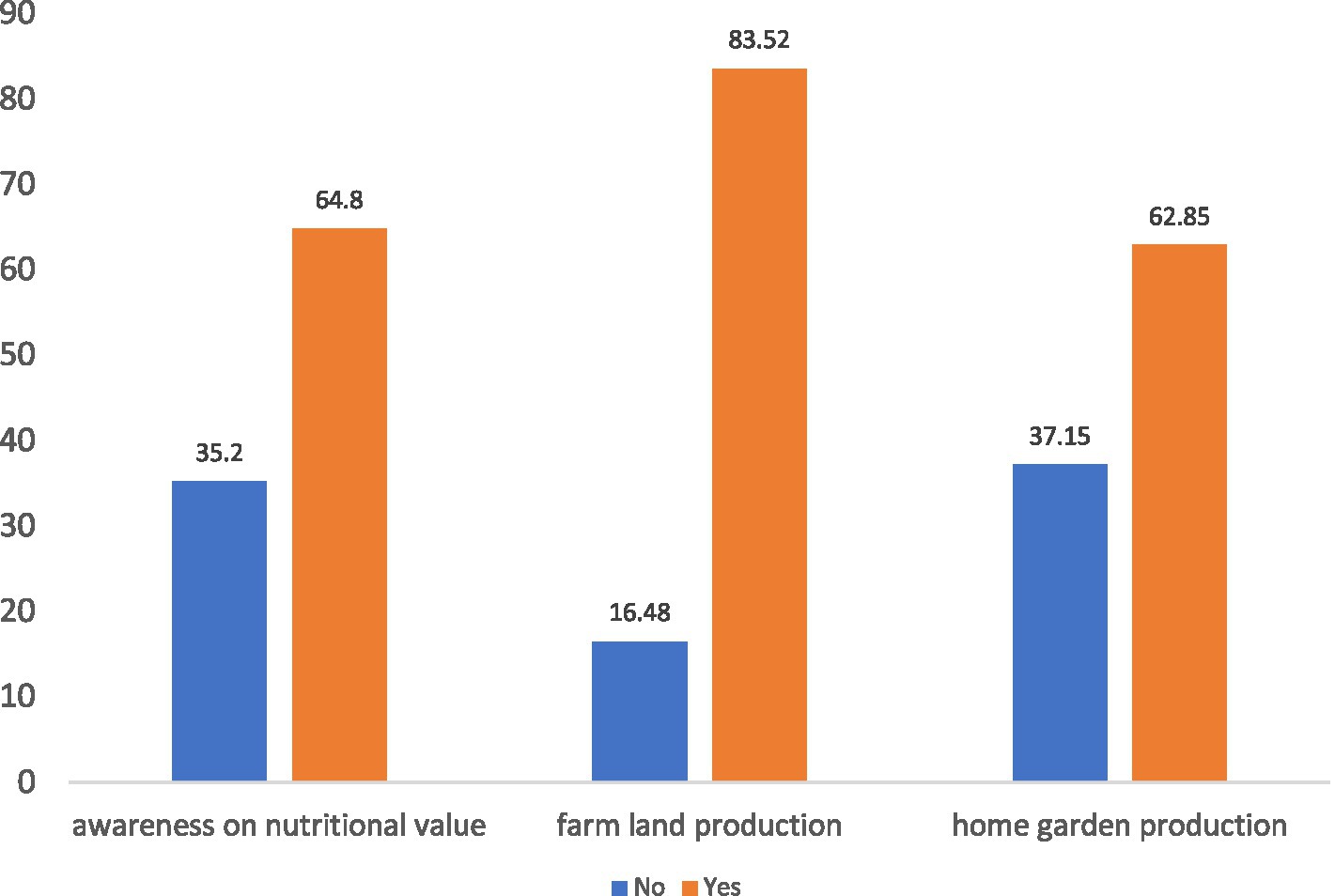
Figure 7. Factors influencing the production, processing, and market accessibility of indigenous crops in Tanzania.
Farmland production is the dominant method of cultivating indigenous crops, with 84% of households engaged in it. This large-scale production enhances market availability and creates opportunities for commercial processing (Trienekens, 2011). However, constraints such as limited land access, declining soil fertility, and climatic conditions can influence production levels (Guodaar et al., 2021). For instance, sorghum and Bambara groundnut are known for their drought tolerance and climate resilience. These crops are often considered climate-smart due to their ability to withstand harsh environmental conditions, including droughts and poor soil fertility, making them valuable for sustainable food security.
If these challenges remain unaddressed, indigenous crops may not reach their full potential in addressing micronutrient deficiencies. In contrast, home garden production, practiced by 63% of households, provides a more accessible and sustainable way to cultivate nutrient-rich crops, especially for subsistence use. Home gardens ensure a steady supply of fresh produce for households, reducing dependency on external markets. However, the fact that 37% of households do not engage in home gardening suggests that more efforts are needed to promote this practice, particularly among vulnerable populations who may lack access to farmland (Figure 7).
Overall, these factors collectively shape the production, processing, and market accessibility of indigenous crops. High awareness levels can drive demand, while strong farmland production supports commercial-scale availability. However, the relatively lower home garden production and limited processing opportunities suggest areas for improvement. Expanding home gardens and increasing processing capacities can enhance value addition and improve market access (Simon et al., 2020). Addressing gaps in awareness, land access, and processing infrastructure is essential to maximizing the role of indigenous crops in combating micronutrient deficiencies and strengthening food systems (Sharma et al., 2024).
3.7 Challenges, gaps, and opportunities for indigenous crops
3.7.1 Challenges in market competitiveness
Indigenous crops face numerous challenges in the quest to become competitive in local, regional, and international markets. One key issue is the limited consumer awareness of their nutritional and economic benefits (FAO, 2019). Despite being nutrient-dense and climate-resilient, these crops are often perceived as inferior, especially in urban and international markets, where they are sometimes labeled as poor man’s food (Vats, 2015). This stigma undermines their social acceptance and economic potential. The shift from indigenous staples like sorghum and millets to mainstream crops such as wheat is driven by factors like perceived status, urbanization, and the availability of imported grains. While mainstream crops may be more accessible in urban markets, they lack the nutritional density and climate resilience of indigenous crops. This shift threatens food security and the preservation of cultural food practices. Exploring the health benefits of indigenous crops, such as their role in combating malnutrition and enhancing gut health, could encourage their adoption and safeguard cultural food heritage.
Market integration is further hindered by weak linkages within the value chain, limiting farmers’ access to local, regional, and global markets. Inadequate comprehensive research and development has resulted in poor yields, low pest resistance, and ineffective post-harvest techniques, exacerbating losses and reducing profitability (Simon et al., 2020). Additionally, fragmented value chains, inadequate infrastructure—such as poor roads, limited cold storage—and limited access to financing further constrain the scalability and marketability of indigenous crops (Barucha and Pretty, 2010).
Poor coordination between smallholder farmers and processing industries results in inconsistent supply and underutilized process capacity. The absence of strong farmer cooperatives weakens bargaining power, leading to low market penetration and exploitative pricing. Furthermore, weak institutional support and limited agricultural extension services hinder the adoption of improved farming practices and post-harvest handling techniques, reducing productivity and competitiveness. Addressing these challenges through improved infrastructure, farmer cooperatives, targeted research investments, and supportive policies could enhance the market potential of indigenous crops.
3.7.2 Opportunities in a changing global context
Despite various challenges, indigenous crops present significant opportunities in addressing pressing global issues like food security, climate change, and biodiversity loss. Many indigenous crops, such as millet, sorghum, amaranth, and teff, are naturally drought-tolerant and require fewer inputs, making them ideal candidates for climate-smart agriculture (FAO, 2021). Their adaptability to marginal soils and semi-arid conditions make them ideal for regions experiencing erratic weather patterns due to climate change (Chivenge et al., 2015).
Beyond their environmental benefits, indigenous crops hold strong market potential in the global health and wellness industry. The rising demand for superfoods—rich in micronutrients and bioactive compounds—positions these crops as attractive options for health-conscious consumers. Their natural nutritional density, high antioxidant content, and bioactive compounds make them valuable in promoting human health (Aderibigbe et al., 2022; Vincent et al., 2023). Additionally, the rise of organic and sustainable food movements has further amplified consumer interest, particularly among those seeking ethical and diverse food choices (Padulosi et al., 2019; Simon et al., 2020). By marketing indigenous crops as organic, sustainable, and culturally unique, they can gain traction in premium and niche markets, ultimately contributing to both economic development and food security (Guodaar et al., 2021; Weinberger and Msuya, 2004).
3.7.3 Bridging the gaps
To bridge the gaps and fully harness these opportunities, targeted interventions are essential. Strengthening value chains through investments in infrastructure, such as storage facilities, transportation networks, and processing plants, can reduce post-harvest losses, maintain crop quality, and enhance marketability (Conti et al., 2021). As such, cold chain systems can extend shelf life, enabling access to distant markets (FAO, 2021). Training programs for farmers can promote sustainable cultivation practices and improve productivity, while policies that incentivize indigenous crop farming can level the playing field with dominant cash crops (Barucha and Pretty, 2010).
Furthermore, digital platforms and e-commerce offer innovative ways to connect producers directly with consumers, enabling them to tap into wider markets without relying on traditional supply chains. Lastly, the governments can establish supportive policies, such as subsidies, tax incentives, and inclusion in food security programs, to boost indigenous crop production and competitiveness (Akinola et al., 2020).
3.7.4 Consumer education and value addition
Consumer education is critical to changing perceptions and increasing demand for indigenous crops. Raising awareness about the health benefits of indigenous crops, cultural significance, and ecological sustainability can shift consumer preferences and elevate their status in both local and global markets (Padulosi et al., 2019). This is particularly important in urban and global markets, where consumers are increasingly prioritizing health and sustainability.
Investing in value-added products such as fortified flours, snacks, and beverages, can help stakeholders create new revenue streams while appealing to modern consumer tastes (Vats, 2015). Through coordinated efforts in research, policy, and market development, indigenous crops can transition from being underutilized resources to competitive, sustainable commodities that contribute to food security, biodiversity, and rural livelihoods.
Key interventions include nutrition education, improved storage and processing technologies, the promotion of indigenous crops, and policies that empower women in household decision-making (FAO, 2021; National Bureau of Statistics and UNICEF, 2018). These strategies are particularly relevant in the Southern Highlands of Tanzania (Njombe and Iringa), where malnutrition and stunting remain prevalent, despite being major producers of nutrient-rich crops.
3.7.5 Collaboration and innovation
Public-private partnerships (PPPs) and international collaborations can play a pivotal role in transforming the indigenous crop sector. Mobilizing funding, facilitating technology transfer, and initiating market development projects can accelerate growth (Chivenge et al., 2015). Partnerships with global organizations like the FAO or regional bodies can also amplify efforts to integrate indigenous crops into sustainable agricultural and food systems (FAO, 2021).
PPPs enhance research and development, improve processing technologies, and facilitate market development by promoting these crops as valuable commodities. PPPs are most effective in marketing and consumption, where they help change public perceptions and boost demand. Studies show successful cases, such as quinoa’s rise to a global superfood (Jacobsen, 2011) and orange-fleshed sweet potato campaigns in Kenya improving nutrition (Low et al., 2007). By mobilizing resources and expertise, PPPs help integrate indigenous crops into sustainable food systems.
4 Conclusion
This study explored the role of indigenous crops in addressing micronutrient deficiencies, enhancing food security, and promoting sustainable agriculture in Southern highlands of Tanzania. Micronutrient deficiencies, particularly vitamin A, iron, zinc, and folate, remain a major public health concern in Tanzania, with high prevalence among women and children. Indigenous crops such as sweet potatoes, amaranth, pumpkin, cowpeas, and baobab offer a promising solution due to their rich nutritional content and adaptability to local conditions. Despite their potential, weak market linkages, inadequate processing infrastructure, and limited policy support hinder their widespread adoption. By analysing the value chain of the indigenous crops in the in the Southern Highlands of Tanzania (Njombe and Iringa), crops such as sweet potatoes, amaranth, pumpkin, cowpeas, and baobab, the research identifies critical gaps in production inputs, processing techniques, and market accessibility. While these crops are nutrient-dense and well-adapted to local conditions, their full potential remains untapped due to weak market linkages, inadequate processing infrastructure, and limited policy support.
Strengthening the value chain through improved agronomic practices, enhanced processing technologies, and strategic market integration is essential to increasing their accessibility and consumption. Additionally, fostering consumer awareness and policy support can position these crops as viable solutions for malnutrition and economic resilience for smallholder farmers. Future research should focus on developing innovative processing methods, enhancing value addition, raising public awareness, and establishing policy frameworks that integrate indigenous crops into mainstream food systems, ensuring their long-term impact on nutrition, livelihoods, and agricultural sustainability.
Data availability statement
The raw data supporting the conclusions of this article will be made available by the authors, without undue reservation.
Ethics statement
The studies involving humans were approved by William A. L. Anangisye, University of Dar es Salaam. The studies were conducted in accordance with the local legislation and institutional requirements. The participants provided their written informed consent to participate in this study.
Author contributions
IJ: Conceptualization, Data curation, Formal analysis, Funding acquisition, Investigation, Methodology, Project administration, Resources, Software, Supervision, Validation, Visualization, Writing – original draft, Writing – review & editing. VV: Conceptualization, Data curation, Formal analysis, Methodology, Project administration, Writing – original draft, Writing – review & editing.
Funding
The author(s) declare that financial support was received for the research and/or publication of this article. This research work received financial support from the institute of food technologists (IFT), us through the seeding the future global food system challenge award.
Acknowledgments
We are grateful to acknowledge the financial support from the Institute of Food Technologists (IFT), for project no. CoAF-AEB23001. The authors would also like to thank the interviewees, who volunteered to participate in the nutritional survey study.
Conflict of interest
The authors declare that the research was conducted in the absence of any commercial or financial relationships that could be construed as a potential conflict of interest.
Generative AI statement
The authors declare that no Gen AI was used in the creation of this manuscript.
Publisher’s note
All claims expressed in this article are solely those of the authors and do not necessarily represent those of their affiliated organizations, or those of the publisher, the editors and the reviewers. Any product that may be evaluated in this article, or claim that may be made by its manufacturer, is not guaranteed or endorsed by the publisher.
References
Abebe, B. K., and Alemayehu, M. T. (2022). A review of the nutritional use of cowpea (Vigna unguiculata L. Walp) for human and animal diets. J. Agric. Food Res. 10:100383. doi: 10.1016/j.jafr.2022.100383
Aderibigbe, O. R., Ezekiel, O. O., Owolade, S. O., Korese, J. K., Sturm, B., and Hensel, O. (2022). Exploring the potentials of underutilized grain amaranth (Amaranthus spp.) along the value chain for food and nutrition security: a review. Crit. Rev. Food Sci. Nutr. 62, 656–669. doi: 10.1080/10408398.2020.1825323
Akinola, R., Pereira, L. M., Mabhaudhi, T., De Bruin, F. M., and Rusch, L. (2020). A review of indigenous food crops in Africa and the implications for more sustainable and healthy food systems. Sustain. For. 12:3493. doi: 10.3390/su12083493
Andiku, C., Shimelis, H., Shayanowako, A. I., Gangashetty, P. I., and Manyasa, E. (2022). Genetic diversity analysis of east African sorghum (Sorghum bicolor [L.] Moench) germplasm collections for agronomic and nutritional quality traits. Heliyon 8:e09690. doi: 10.1016/j.heliyon.2022.e09690
Asogwa, O. A., Boateng, D., Marzà‑Florensa, A., Peters, S., Levitt, N., van Olmen, J., et al. (2022). Multimorbidity of non‑communicable diseases in low‑income and middle‑income countries: A systematic review and meta‑analysis. BMJ Open, 12: e049133. doi: 10.1136/bmjopen-2021-049133
Badrie, N. (2016). Nutrient profile, bioactive components, and functional properties of okra. In V. R. Preedy (Ed.), Fruits, vegetables, and herbs: Nutritional and therapeutic values Academic Press. 337–352. doi: 10.1016/B978-0-12-802972-5.00018-4
Barucha, Z., and Pretty, J. (2010). The roles and values of wild foods in agricultural systems. Philos. Trans. R. Soc. Lond. Ser. B Biol. Sci. 365, 2913–2926. doi: 10.1098/rstb.2010.0123
Byrnes, D. R. (2018). Improvement of African indigenous vegetables for stable delivery of micronutrients. New Brunswick, NJ: Rutgers University-School of Graduate Studies.
Chivenge, P., Mabhaudhi, T., Modi, A., and Mafongoya, P. (2015). The potential role of neglected and underutilized crop species as future crops under water-scarce conditions in sub-Saharan Africa. Int. J. Environ. Res. Public Health 12, 5685–5711. doi: 10.3390/ijerph120605685
Conti, M. V., De Giuseppe, R., Monti, M. C., Mkindi, A. G., Mshanga, N. H., Ceppi, S., et al. (2021). Indigenous vegetables: a sustainable approach to improve micronutrient adequacy in Tanzanian women of childbearing age. Eur. J. Clin. Nutr. 75, 1475–1482. doi: 10.1038/s41430-021-00865-x
Cunningham, S., and Saqib, M. (2020). Value chain development to empower smallholder farmers: case studies and lessons from developing countries. Int. J. Agric. Sustain. 18, 68–81.
Donovan, J., Franzel, S., Cunha, M., Gyau, A., and Mithöfer, D. (2015). Guides for value chain development: a comparative review. J. Agribus. Dev. Emerg. Econ. 5, 2–23. doi: 10.1108/JADEE-07-2013-0025
Faizal, F. I., Ahmad, N. H., Yaacob, J. S., Halim-Lim, S. A., and Rahim, M. A. (2023). Food processing to reduce antinutrients in plant-based foods. Int. Food Res. J. 30, 25–45. doi: 10.47836/ifrj.30.1.02
FAO (2019). The state of the world’s biodiversity for food and agriculture FAO commission on genetic resources for food and agriculture. Paris: FAO.
FAO (2021). Indigenous peoples’ food systems: Insights on sustainability and resilience from the front line of climate change. Paris: FAO.
Gemede, H. F., Haki, G. D., Beyene, F., Woldegiorgis, A. Z., and Rakshit, S. K. (2016). Proximate, mineral, and antinutrient compositions of indigenous okra (Abelmoschus esculentus) pod accessions: implications for mineral bioavailability. Food Sci. Nutr. 4, 223–233. doi: 10.1002/fsn3.282
Gowele, V. F., Kinabo, J., Jumbe, T., Rybak, C., and Stuetz, W. (2021). High prevalence of stunting and anaemia is associated with multiple micronutrient deficiencies in school children of small-scale farmers from Chamwino and Kilosa districts, Tanzania. Nutrients 13:1576. doi: 10.3390/nu13051576
Guodaar, L., Bardsley, D. K., and Suh, J. (2021). Indigenous adaptation to climate change risks in northern Ghana. Clim. Chang. 166:24. doi: 10.1007/s10584-021-03128-7
Hawkes, C., and Ruel, M. T. (2011). Value chains for nutrition. International Food Policy Research Institute (IFPRI). Available at: https://a4nh.cgiar.org/files/2013/06/ValueChainsForNutrition.pdf
Hellin, J., and Meijer, M. (2006). Guidelines for value chain analysis. Paris: Food and Agriculture Organization (FAO).
Jacobsen, S. E. (2011). The situation for quinoa and its production in southern Bolivia: from economic success to environmental disaster. J. Agron. Crop Sci. 197, 390–399. doi: 10.1111/j.1439-037x.2011.00475.x
Jahiruddin, M. (2020). Bio-fortification of food crops: a novel strategy for reducing micronutrient malnutrition. FAA 5, 133–146. doi: 10.5455/FAA.96078
Kaplinsky, R., and Morris, M. (2001). A handbook for value chain research. Ottawa, ON: International Development Research Centre (IDRC).
Kumar, S., Das, A., Kasala, K., and Ravula, P. (2022). Micronutrient-sensitive food value chains: a systematic review of intervention strategies and impact pathways to nutritional outcomes. CABI Rev. 17, 1–14. doi: 10.1079/cabireviews202217012
Low, J. W., Arimond, M., Osman, N., Cunguara, B., Zano, F., and Tschirley, D. (2007). A food-based approach introducing orange-fleshed sweet potatoes increased vitamin a intake and serum retinol concentrations in young children in rural Mozambique. J. Nutr. 137, 1320–1327. doi: 10.1093/jn/137.5.1320
Lyons, G., Gondwe, C., Banuelos, G., Mendoza, C., Haug, A., Christophersen, O., et al. (2017). Drumstick tree (Moringa oleifera) leaves as a source of dietary selenium, Sulphur and pro-vitamin a. Acta Hortic. 1158, 287–292. doi: 10.17660/ActaHortic.2017.1158.32
Majili, Z. S., Nyaruhucha, C., Kulwa, K., and Rybak, C. (2023). Development and profiling of affordable and nutritionally optimal pigeon pea-based products for improved recipes diversification in rural communities in Tanzania. East Afr. J. Sci. Technol. Innov. 4:704. doi: 10.37425/eajsti.v4i3.704
Naeem, M., Shabbir, A., Ansari, A. A., Aftab, T., Khan, M. M. A., and Uddin, M. (2020). Hyacinth bean (Lablab purpureus L.)–an underutilised crop with future potential. Sci. Hortic. 272:109551. doi: 10.1016/j.scienta.2020.109551
National Bureau of Statistics and UNICEF. (2018). The State of Mainland Tanzania’s Children: Tanzania National Nutrition Survey. 2018. National Bureau of Statistics & UNICEF. doi: 10.1017/S1368980018002434
Ngadze, R. T., Linnemann, A. R., Nyanga, L. K., Fogliano, V., and Verkerk, R. (2016). Local processing and nutritional composition of indigenous fruits: the case of monkey orange (Strychnos spp.) from southern Africa. Food Rev. Int. 33, 123–142. doi: 10.1080/87559129.2016.1149862
Ojwang, R. (2020). Nutritional, phytochemical, antioxidant and genetic characterization of jackfruits (Artocarpus heterophyllus) found in selected regions of Kenya and Uganda (Doctoral dissertation). Nairobi: University of Nairobi.
Owusu, D., Ellis, W. O., and Oduro, I. (2008). Nutritional potential of two leafy vegetables: Moringa oleifera and Ipomoea batatas leaves. Available online at: https://www.academia.edu/download/50632768/Oduro_et_al_2008_Nutritional_Potential_of_two_leafy_vegetables_Moringa_oleifera_and_Ipomoea_batata_leaves.pdf (Accessed January 11, 2025).
Padulosi, S., Thompson, J., and Rudebjer, P. (2019). Fighting poverty, hunger, and malnutrition with neglected and underutilized species: needs, challenges, and the way forward. Delhi: Bioversity International.
Pandharmise, P. N., Deshmukh, G. T., and Shinde, N. V. (2022). Cleaning validation for oral solid dosage form and its importance in pharma industry.. Res J Pharm Technol. 15:1605–1610. doi: 10.52711/0974-360X.2022.00249
Rousseau, S., Kyomugasho, C., Celus, M., Hendrickx, M. E., and Grauwet, T. (2020). Barriers impairing mineral bioaccessibility and bioavailability in plant-based foods and the perspectives for food processing. Crit. Rev. Food Sci. Nutr. 60, 826–843. doi: 10.1080/10408398.2018.1552243
Samtiya, M., Aluko, R. E., and Dhewa, T. (2020). Plant food anti-nutritional factors and their reduction strategies: an overview. Food Prod. Process. Nutr. 2:6. doi: 10.1186/s43014-020-0020-5
Sangija, F., Martin, H., and Matemu, A. (2021). African nightshades (Solanum nigrum complex): the potential contribution to human nutrition and livelihoods in sub-Saharan Africa. Compr. Rev. Food Sci. Food Saf. 20, 3284–3318. doi: 10.1111/1541-4337.12756
Sarker, U., and Oba, S. (2019). Nutraceuticals, antioxidant pigments, and phytochemicals in the leaves of Amaranthus spinosus and Amaranthus viridis weedy species. Sci. Rep. 9:20413. doi: 10.1038/s41598-019-50977-5
Schipmann, C., and Qaim, M. (2011). Supply chain differentiation, contract agriculture, and farmers’ marketing preferences: The case of sweet pepper in Thailand. Food Policy. 36, 667–677. doi: 10.1016/j.foodpol.2011.05.005
Sharma, A., Singh, A., Rajput, V. D., Minkina, T., Mandzhieva, S., Elshikh, M. S., et al. (2024). “Crop biofortification innovative solutions for micronutrient deficiency” in Nanotechnology applications and innovations for improved soil health. ed. V. D. Rajput (London: IGI Global), 289–304.
Shobana, S., Krishnaswamy, K., Sudha, V., Malleshi, N. G., Anjana, R. M., Palaniappan, L., et al. (2013). Finger millet (Ragi, Eleusine coracana L.): a review of its nutritional properties, processing, and plausible health benefits. Adv. Food Nutr. Res. 69, 1–39. doi: 10.1016/B978-0-12-410540-9.00001-6
Simon, J. E., Weller, S., Hoffman, D., Govindasamy, R., Morin, X., Merchant, E. V., et al. (2020). Improving income and nutrition of smallholder farmers in eastern Africa using a market-first science-driven approach to enhance value chain production of African indigenous vegetables. J. Medic. Act. Plants 9, 289–309. doi: 10.7275/sj66-1p84
Termote, C., Odongo, N. O., Dreyer, B. S., Guissou, B., Parkouda, C., and Vinceti, B. (2020). Nutrient composition of Parkia biglobosa pulp, raw and fermented seeds: a systematic review. Crit. Rev. Food Sci. Nutr. 62, 119–144. doi: 10.1080/10408398.2020.1813072
TNNS (2018). Tanzania National Nutrition Survey using SMART methodology. Dar es Salaam: MoHCDGEC, MoH, TFNC, NBS, OCGS, and UNICEF.
Trienekens, J. H. (2011). Agricultural value chains in developing countries a framework for analysis. Int. Food Agribus. Manage. Rev. 14, 51–82. doi: 10.22004/ag.econ.103987
Vats, C. (2015). Promotion of neglected old crops for nutritional security. J. Krishi Vigyan 4, 76–79. doi: 10.5958/2349-4433.2015.00065.3
Vincent, V., Laura, C., Simon, S., Dominique, V., and Der, S. (2023). The role of orphan crops in the transition to nutritional quality-oriented crop improvement. Biotechnol. Adv. 68:108242. doi: 10.1016/j.biotechadv.2023.108242
Weinberger, K., and Msuya, J. M. (2004). Indigenous vegetables in Tanzania: Significance and prospects, vol. 600. Tainan: AVRDC-World Vegetable Center.
Keywords: micronutrients deficiencies, nutrition value, value chain, double indigenous crops, Tanzania
Citation: John I and Vicent V (2025) A deep dive into the dynamics of indigenous crops: nutritional value, production patterns, and market accessibility in Southern Highlands of Tanzania. Front. Sustain. Food Syst. 9:1570750. doi: 10.3389/fsufs.2025.1570750
Edited by:
Agnes Mwangwela, Lilongwe University of Agriculture and Natural Resources, MalawiReviewed by:
Kwaku Gyebi Duodu, University of Pretoria, South AfricaJohn Lubaale, University College Birmingham, United Kingdom
Copyright © 2025 John and Vicent. This is an open-access article distributed under the terms of the Creative Commons Attribution License (CC BY). The use, distribution or reproduction in other forums is permitted, provided the original author(s) and the copyright owner(s) are credited and that the original publication in this journal is cited, in accordance with accepted academic practice. No use, distribution or reproduction is permitted which does not comply with these terms.
*Correspondence: Innocensia John, aW5ub2NlbnNpYUB1ZHNtLmFjLnR6
 Innocensia John
Innocensia John Victor Vicent
Victor Vicent